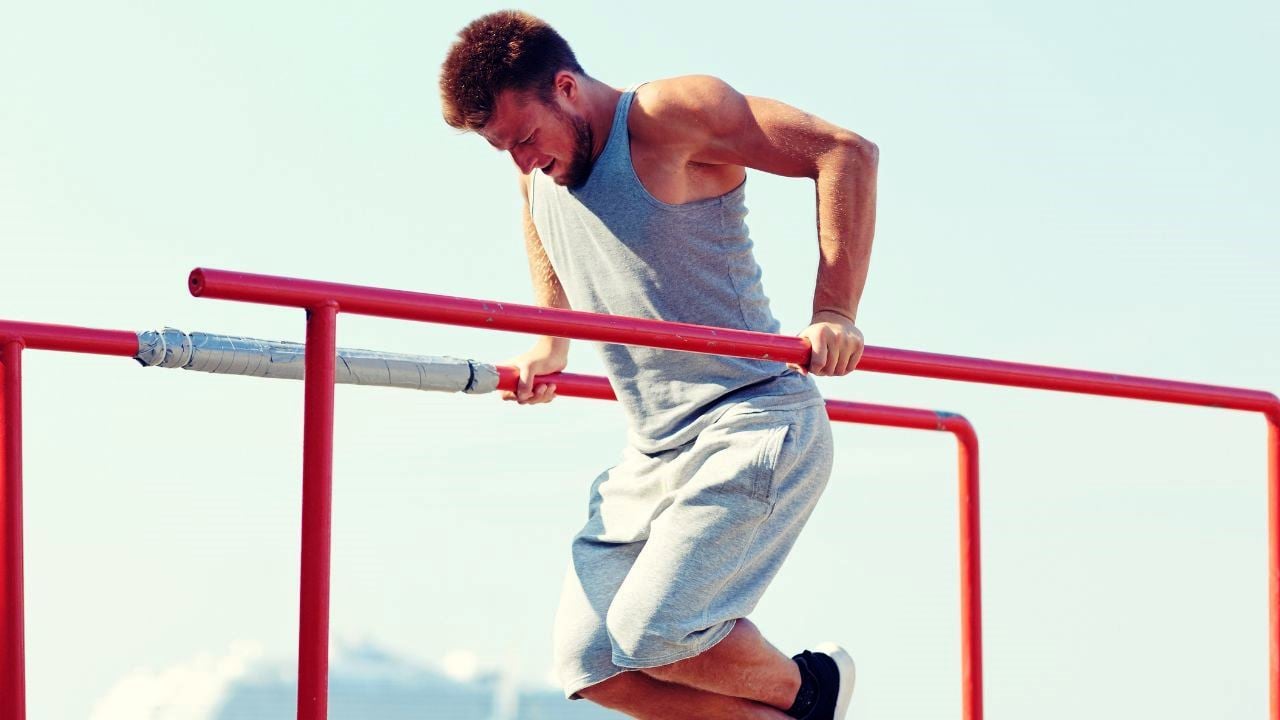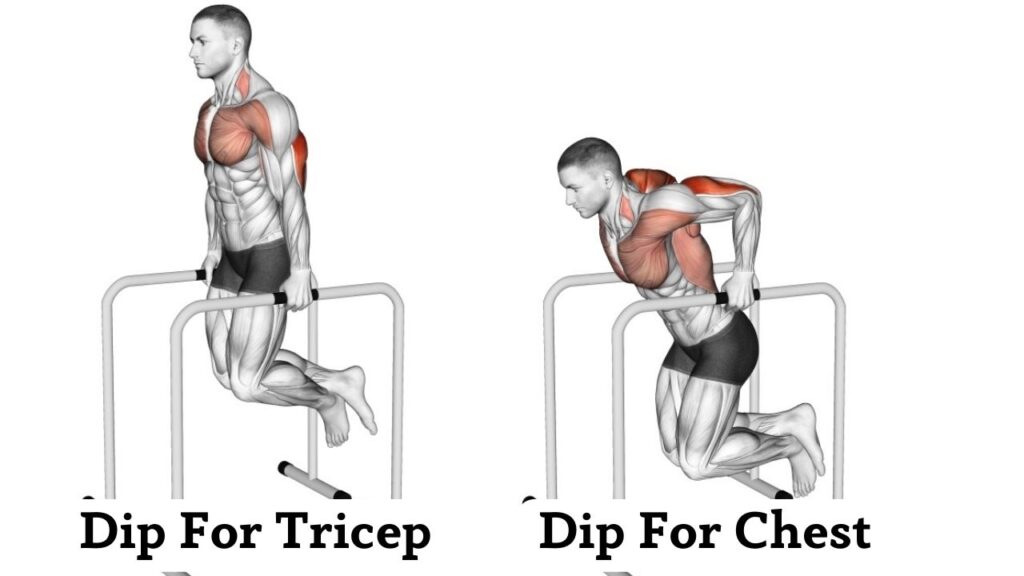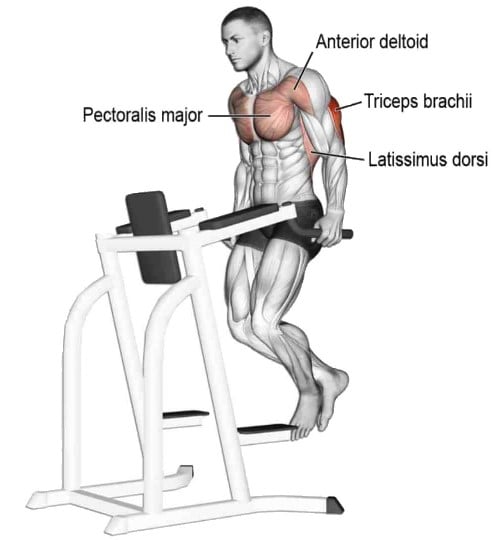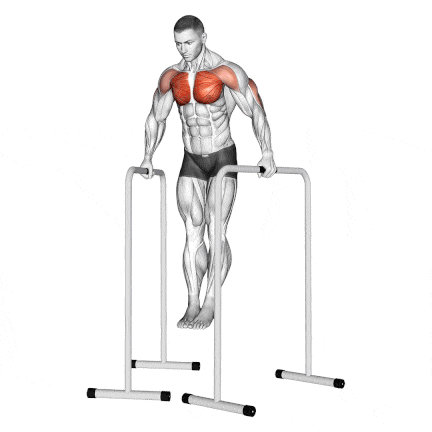Parallel bar dips also know as bar dips are a highly effective compound exercise that primarily targets the chest, triceps, and shoulder muscles while also engaging the upper back muscles, including the trapezius, for stability.
Due to its numerous benefits, this exercise is a staple in many strength training and calisthenics programs to build muscular hypertrophy, upper body strength, and/or endurance.
One of the unique benefits of the parallel bar dip is the ability to overload the triceps with a greater range of motion than other triceps exercises like skull crushers or triceps pushdowns.
Another advantage of this exercise is its closed-chain movement, meaning your hands are fixed in position rather than free-moving. Closed-chain exercises are generally safer for shoulder joints and help improve stabilization strength across the upper body musculature.
As strength progresses, resistance must also be. Incorporating additional weight via dumbbells, chin/dip belts, or lifting chains ensures continued growth and adaptation.

Parallel Bar Dip For Chest or Tricep
Parallel bar dips target both your chest (pectorals), but how you position your body and hand shifts the stimulation from the tricep to the chest and vice versa.
For Chest Engagement
The chest muscles, specifically the pectoralis major, are responsible for internal rotation, and adduction of the arm in the shoulder joint.
When you do parallel bar dips in a leaned forward position, it places more emphasis on the chest. Imagine pushing your chest out in front of your shoulders as you descend.
If you do the dip on the straight bar, which involves a more internal rotation of the shoulders, you tend to stimulate the chest muscles more than the parallel bar dip.

For Triceps Engagement
When you do the parallel bar dip in a more upright position, it effectively targets the triceps. During the exercise, also keep your elbows close to your body.
The triceps brachii muscle helps with elbow extension. When you do a parallel bar dip, you can do the full range of elbow extensions, which helps you train your triceps hard.
The parallel bar dip is considered a better option for triceps development than the straight bar dip, as it allows for a greater range of motion and a more neutral shoulder position. This reduces the risk of injury and allows for heavier weights to be used.
Bar Dips Muscles Worked
- During parallel bar dips, the primary muscles worked include the chest (pectoralis major and pectoralis minor), triceps, and anterior deltoids. These muscles do most of the work during the exercise.
- Several stabilizing muscles, such as the serratus anterior, rotator cuff muscles, core muscles, and trapezius, also work to maintain form and stability during parallel bar dips.

How To Do Parallel Bar Dip
- Stand facing a dip station or locate a sturdy set of parallel bars at a height that allows your feet to clear the ground when hanging.
- Stand between the parallel bars and grip each bar firmly with an overhand grip.
- For optimal stability, grab the bars a hand with wider than shoulder-width apart.
- Jump up or use a small step to lift yourself onto the bars. Hang freely with your arms extended, palms facing inward, and feet off the ground.
- Keep leaning forward to train your chest or upright to focus on your triceps.
- Keep your elbows out to your sides as you lower yourself down, dropping until your upper arms are about parallel to the floor.
- Once you’ve reached the bottom of the movement, reverse the motion by pressing through your palms and straightening your arms.
- Push yourself upward until your arms are fully extended, but be careful not to lock out your elbows at the top.

Tips and Form
- Keep your elbows tucked close to your body and avoid flaring them out to the sides.
- Avoid dipping down too far as this can put excessive stress on your shoulder joints.
- If needed, you can bend your legs to assist with the movement, especially on the later reps.
- To target the chest, lean forward and position the chest in front of the elbows during the dip.
- To effectively target the triceps, keep the body upright and the upper arms close to the body.
- Keep your torso upright and avoid leaning too far forward or backward.
- Breathe out as you push yourself upward and inhale as you lower your body downward.
- Avoid fully locking your elbows at the top of the movement when pushing yourself back up to prevent joint strain.
- If you’re new to doing dips, start with assisted dips using a machine, a band or someone who can help you.
- Once bodyweight dips become easy, add weight using a dip belt or a dumbbell between your legs.
Reference
- McKenzie, A.; Crowley-McHattan, Z.; Meir, R.; Whitting, J.; Volschenk, W. Bench, Bar, and Ring Dips: Do Kinematics and Muscle Activity Differ? Int. J. Environ. Res. Public Health 2022, 19, 13211. https://doi.org/10.3390/ijerph19201321
- Boehler, B A. “Electromyographic analysis of the triceps brachii muscle during a variety of triceps exercises.” (2011).

Manish is a NASM-certified fitness and nutrition coach with over 10 years of experience in weight lifting and fat loss fitness coaching. He specializes in gym-based training and has a lot of knowledge about exercise, lifting technique, biomechanics, and more.
Through “Fit Life Regime,” he generously shares the insights he’s gained over a decade in the field. His goal is to equip others with the knowledge to start their own fitness journey.
